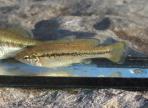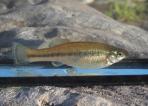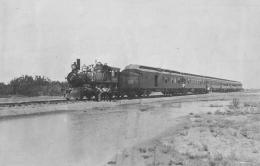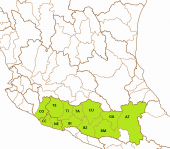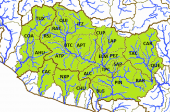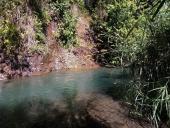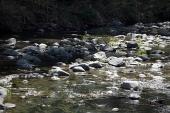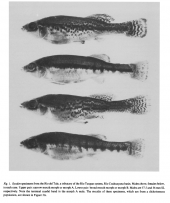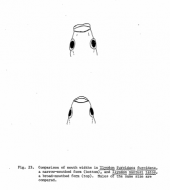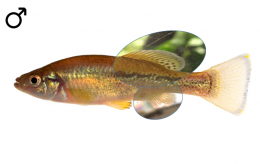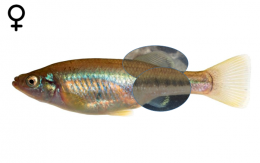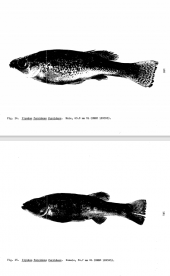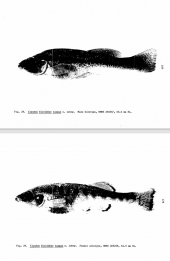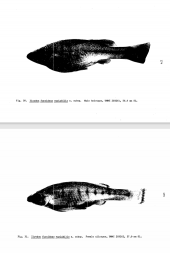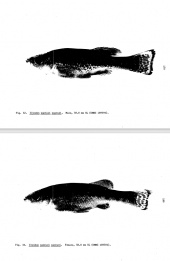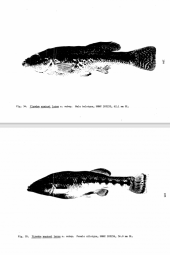Ilyodon whitei (incl. cortesae, lennoni and parts of xantusi)
MEEK, S. E. (1904): The fresh-water fishes of Mexico north of the Isthmus of Tehuantepec. Publication. Field Columbian Museum 93, Zoological Series 5: pp 137-138
Collection-number: Field Columbian Museum, Cat. No. FMNH-4547.
The Holotype is a female of 71.5mm TL length, collected on March, 27th, 1903 by Meek himself. Together with the Holotype were collected 274 individuals, Cat. No's. in the FCM: FMNH-72572 (17 individuals) and FMNH-4548 (257 individuals), and eventually 31 more, cataloged under FMHN-55771, but that's not confirmed with the collection date.
The left picture shows a drawing of the Holotype of Ilyodon whitei, the right one a photography from 1905 of an old steam engine train in Mexicali, Baja California. Though the picture is not taken near a habitat of the Balsas Splitfin, with the waterbody next to the rails, it gives a good impression how Meek travelled and collected fish at the beginning of the last century:
The Holotype was collected from upper tributaries of the Río Balsas near Yautepec, Mexican federal state of Morelos.
The species is named for E. A. White of the city of Mexico, in recognition of many favours Meek received through his courtesy. White was working for the Interoceanic Railway Company, and taking in consideration that Meek travelled mainly by train (most of his discoveries happened next to railway stations), this gives an hint for Meeks choice of this epithet.
The genus Ilyodon was erected by Carl Eigenmann in 1907 without giving an explicite explanation for the reason. He indeed mentioned that the teeth were close set, but the etymology of the generic name means something slightly different. It can be derived from the ancient Greek with λύω (lýō) in the translation of "to loosen" and ὀδόντον (ódónton) the akkusative of ὁδούς (ódoús), the tooth. The prefix "in" in Latin (or asimilated il in this case) means not, without or opposite, therefore the translation could be "not to loosen a tooth" or figurative "firmly attached tooth".
Goodea whitei Meek, 1904
Balsadichthys whitei Hubbs, 1926
Ilyodon furcidens furcidens Kingston, 1979, partially (nomen nudum)
Ilyodon furcidens tuxpan Kingston, 1979 (nomen nudum)
Ilyodon xantusi xantusi Kingston, 1979, partially (nomen nudum)
Ilyodon xantusi latos Kingston, 1979 (nomen nudum)
Ilyodon lennoni Meyer & Förster, 1983
Ilyodon cortesae Paulo-Maya & Trujillo-Jiménez, 2000
The Balsas Splitfin is endemic to the Mexican federal states of Michoacán, Mexico, Morelos, Guerrero and Puebla. It is known from the Río Coahuayana drainage except for the Río Salado drainage (Ilyodon furcidens), from some rivers of the Michoacán coast like the ríos Coalcomán and Nexpe, and from most of the eastern reaches of the Río Balsas, starting in the E with the ríos Nexapa, Grande de Amacuzac, Tepecuacuilco and Cocula, then the ríos Oxtotitlán, Palos Altos, Cutzamala, Tacámbaro, and the arroyos San Lucas and Grande and the Río Chiquito in the Central Río Balsas drainage, and finally the Río Tepalcatepec, western Río Balsas affluent. According to last phylogenetic results, five subpopulations can be inferred: The Río Amacuzac subpopulation (type subpopulation), the Río Atoyac subpopulation, the Central-Western Río Balsas subpopulation, and the Upper and Lower Río Coahuayana subpopulations. The bold names are the ones officially used by the Instituto Nacional de Estadística y Geografía; nevertheless, other ones might be more often in use or better known and therefore prefered.
ESU ist short for Evolutionarily Significant Unit. Each unit expresses an isolated population with different genetic characteristics within one species. ESU's can be defined by Molecular genetics, Morphology and/or Zoogeography and help in indicating different phylogenetic lineages within a species. The abbreviation for an ESU is composed of three letters of the genus, followed by the first two letters of the species name and an ongoing number in each species.
In Ilyodon whitei, we actually accept five ESU's, following the last phylogenetic results (Beltrán-Lopez et al., 2017). We separate Ilywh1 (Clade D sensu Beltrán-Lopez) from the upper Coahuayana (Río Tuxpan) drainage from Ilywh2 (Clade C) from the lower Coahuayana based on morphological differences. Ilywh3 (Clade E) from the western and central Río Balsas basin includes the former accepted species Ilyodon cortesae and lennoni. Populations from the Río Grande de Amacuzac and eastern Río Cutzamala affluents (e.g. Río Tilostoc) are encompassed under Ilywh4 (subclade B2), while fish from the Nexapa river form Ilywh5 (subclade B1).
The left map shows the Río Tepalcatepec (TE) and the Río Tepalcatepec-Infiernillo (TI) basins, then the ríos Tacámbaro (TA), Cutzamala (CU), Grande de Amacuzac (GA) and Atoyac (AT) basins in the headwaters of the Río Balsas, and along the Río Balsas the Río Balsas-Mezcala (BM), Río Balsas-Zirándaro (BZ) and Río Balsas-Infiernillo (BI) basins. All these basins belong to the Hydrographic Region Balsas. The left map shows also, that this species additionally can be found in the ríos Cachan o Coalcomán y otros (CC) and Nexpe y otros (NE) basins from the Hydrographic Region Costa de Michoacán, and that most of the Ilyodon populations from the Río Coahuayana basin (CO) from the Hydrographic Region Armería-Coahuayana are regarded as Ilyodon whitei. The middle map shows the populated subbasins from the eastern half of its distribution range, starting with the easternmost one, the Río Nexapa subbasin (NEX) from the Río Atoyac basin. It is followed by the Río Grande de Amacuzac basin and almost all of its subbasins, the Río Yautepec subbasin (YAU) with the type locality, and the ríos Alto (AAM) and Bajo (BAM) Amacuzac, Apatlaco (APA), Cuautla (CUA) and Coatlán (RCO) subbasins. It is followed by its neighbouring basin and right Río Balsas affluent, the Río Cutzamala basin with its subbasins. These are the ríos Purungueo (PUR), Tuxpan (TXP - not to confuse with the subbasin of the same name from the Río Coahuayana basin), Tilostoc (TIL), Zitácuaro (ZIT), Temascaltepec (RTE), Ixtapan (IXT) and Cutzamala (CTZ) subbasins. Subbasins of the Río Balsas-Mezcala basin are (again) right affluents of the Balsas river: the ríos Cocula o Iguala (RCI), Puente Verde (PUV), Tepecualcuilco (TEP), and eventually the Rio Balsas-Santo Tomás (BST) subbasin. Within the following Río Balsas section, the Río Balsas-Zirándaro basin, are these the ríos Poliutla (POL) and Huetamo (HUE), and the ríos Balsas-San Cristóbal (BSC) and Balsas-Zirándaro (BZI) subbasins. The right map goes on with the western half of the distribution range of the Balsas Splitfin, starting with the subsequent Río Balsas section, the Río Balsas-Infiernillo basin including the ríos Balsas-Aratichanguio (BAR) and Balsas- La Garita (BLG), and the Presa El Infiernillo (PIN) subbasins, and the Río Tacámbaro basin, again a right affluent of the Balsas river. Its three subbasins are the ríos Carácuaro (CAR), Tacámbaro (TAC) and Quenchendio (QUE) subbasins. The next right Balsas affluent, the Río Tepalcatepec, is split into two basins. The Río Tepalcatepec basin encompasses the westernmost Rio Balsas subbasins, the ríos Itzícuaro (ITZ), Quitupan (QUI), Alto (RAT) and Bajo (BTC) Tepalcatepec, San Jeronimo (RSJ) and Apatzingán (APT), and the Arroyo Tepalcatepec (ATP) subbasins. It is followed by the subbasins of the Río Tepalcatepec-Infiernillo basin, the ríos Cupatitzio (CUP), La Parota (LAP), El Marqués (ELM), San Pedro (SAP) and Tepalcatepec (TPC), and the Arroyo Las Cruces (ALC) and Presa El Zapote (PEZ) subbasins. As mentioned above, besides within the Hydrographic Region Balsas, this species also occurs in the Hydrographic Region Costa de Michoacán, where it inhabits the Río Cachan o Coalcomán (CAC) subbasin, Río Cachan o Coalcomán y otros basin, and the ríos Nexpe (NXP) and Chula (CHU) subbasins, Río Nexpe y otros basin, and in the Hydrographic Region Armería-Coahuayana, where it can be found in the ríos Tuxpan (TUX), Ahuijullo (AHU) and Coahuayana (COA) subbasins, Río Coahuayana basin:
International Union for Conservation of Nature (IUCN): Least Concern
Distribution and current conservation status of the Mexican Goodeidae (Lyons et al., 2019): Vulnerable/declining: „As we define it, this species is found in the Coahuayana and Balsas river basins, where it occurs in ca. 60 sites over a wide range. Specimens from the Chacambero River, a tributary to the Balsas River near the town of Ciudad Altamirano in the state of Guerrero, were described as a separate species, I. lennoni (Meyer and Förster, 1983), but based on limited and inconsistent morphological and genetic differences, we and most other ichthyologists (e.g., Doadrio and Domínguez-Domínguez, 2004; Domínguez-Domínguez et al., 2005; Miller et al., 2005; Beltrán-López et al., 2017) do not consider this species to be valid. Similarly, populations in Tacámbaro River drainage in the upper Balsas River basin were described as a separate species, I. cortesae (Paulo-Maya and Trujillo-Jiménez, 2000), but again morphological and genetic differences between this and other populations are small and inconsistent, and we also do not consider this species to be valid. Many populations of I. whitei have declined or disappeared during the last 25 years, largely because of predation by or competition from non-native fish species (e.g., Contreras-MacBeath et al., 1998) and water pollution. Non-native species now dominate many areas of the Balsas River basin. Of the five ESUs we recognize, Ilywh1, found in the upper Coahuayana River basin in Jalisco is vulnerable. It has declined from many areas but remains abundant where it occurs. Similarly, Ilywh2, distinguished from Ilywh1 based on morphology, from the lower Coahuayana basin in Jalisco, is also vulnerable. It too has declined but is still numerous in several areas. Ilywh3, in the central and western portion of the Balsas River basin and including the nominal I. cortesae and I. lennoni, is the most common and widespread ESU, occurring at ca. 30 sites, but still qualifies as vulnerable. Ilywh4 is classified as vulnerable and is found at ca. 12 sites in the Amacuzac River drainage in the eastern Balsas River basin in the state of Morelos. Ilywh5 is classified as vulnerable and has been reported from approximately ten sites in the Atoyac River drainage of the far eastern Balsas River basin in the state of Puebla.“
NOM-059-SEMARNAT-2010: no categoría de riesgo (no category of risk)
The habitats are similar to the ones of Ilyodon furcidens, means pools and riffles of clear to turbid streams, over substrates of sand, silt, mud, gravel, rocks and boulders. The currents are usually slight to swift. Vegetation can be absent or made of green algae, Potamogeton and Ceratophyllum. The preferred depth is less than 1.3m.
On several surveys of the GWG from 2016-2019 to habitats with the Río Coahuayana drainage, the groups found this species usually in decent to big numbers in very shallow water of depths of only a few centimeters up to depths of about 1m in small and tiny creeks up to rivers. The currents were typically swift, sometimes moderate, and the spieces was found partly in the middle of the current. The only habitat within the Balsas river drainage surveyed so far with a population of Ilyodon whitei was the Presa Catarina in Uruapan during a survey in 2017. Here a narrow path over a wall dams the spring creek up to a 20 x 30m shallow pool and separates it from the rest of the Presa with a passage in the middle. Another wall is on top of this pool, leavig a passage for the moderatly fast flowing creek. Fish could be found on both sides of this little dam. The water was about 50cm deep, the ground made up of silt, mud and sand, with almost evenly distributed rocks and boulders. Those rocks were densily covered with green filamentous and short brown algae and aufwuchs. The shore was partly made up of riparian grass, partly building up dense vegetation growing in the shallow water or hanging over the surface. The habitat was partly shaded by huge willow trees (Salix sp.). Allotoca catarinae was mainly hiding between the rocks or more often in the vegetation. The only other fish at this collection site was another Goodeid species, Allotoca catarinae.
Miller (2005) wrote, that the occurrence of young in collections suggests that the reproduction occurs during the latter part of the dry season in March and April. On a survey of the GWG in March 2016 and March respectively June 2019, young fish of 2 to 3cm could be found, mainly in very shallow and quiet water close to the bank, sometimes hiding in riparian vegetation.
Teeth, gut and dentition is similar to its congener, so the feeding habits are most probably identical, means mainly herbivorous, grazing from aufwuchs and algae and collecting insects from the surface. Two trophic types can be distinguished (by their mouth) in this species: One with a narrow mouth (being suggested to be insectivore or planktivore), and one with a broad mouth (being suggested to feed from aufwuchs and algae). Both types have been seen feeding in the habitat from aufwuchs, the narrow-mouthed form additionally from the surface (Kingston, 1979). The broad mouth form was originally described as Ilyodon xantusi. The gut of both types is long and suggests herbivorous feeding habits.
The left picture shows males (fish one and three from the top) and females (two and four respectively) of a narrow-mouthed form (upper two fish) and a broad-mouthed form (lower two fish), all from the Río Tuxpan drainage, in comparison from a lateral view. The middle picture shows a drawing by D. Kingston of a broad- and a narrow-mouthed form from a top view, and the right picture several mouth forms of fish collected at the Río Tuxpan near Atenquique, all from top views:
The ground colouration of Ilyodon whitei is mostly light brown or grey, in some populations tending to yellow. The upper part of the body is darker than the lower part, the scales have its posterior portion darker giving the fish a finely speckled appearance. A narrow blackish lateral band, extending from above the opercle nearly to the base of the caudal fin, is composed of a lot of small dark dots in males, females often have this band splitted into the single dots. Both sexes have no or very few dots in the fins, but darker areas can be found sometimes, mainly as a short bar in the anal fin. The base of the caudal fin is dotted with several transverse rows of dark dots and the caudal fin itself shows a dark submarginal band followed by a yellowish terminal band in the male gender. Males show a metallic-yellowish or bluish mirror on the sides, sometimes even females can show a hint of it. Many fins show iridescent light parts.
At first appearance, males and females of the Balsas Splitfin might not be very easy to distinguish. The safest characteristic is the Splitfin in males, means the for Goodeinae typical mating organ formed by a notch after the first seven shortened rays of the Anal fin. Additionally, male Ilyodon whitei have a much bigger Dorsal fin than females, and they are usually more intensively coloured. Many males have the caudal fin coloured partly yellow with black rims and/or dots and blotches, in Balsas populations usually the body displays many black dots and blotches, centered in a lateral line, while adult females mostly display a lateral row of bigger dark markings with clear unpaired fins. However, there are also males without any colour markings at all and females displaying a lot of yellow, even in the caudal fin, and sometimes showing also plenty of black dots, spots and markings, so the colour is not such a clear character to distinguish sexes though it might give a good hint.
The Balsas Splitfin was originally placed in the genus Goodea by Meek because of a similar dentition, but Hubbs recognized sufficient differences in the structure of ovaries and trophotaenia and erected therefore the genus Balsadichthys in 1926. The genus Balsadichthiys is one of only five that have been erected exclusively for Goodeid fish and lateron became synonyms. It was seen as genus similar to Ilyodon, but with loose teeth instead of firmly attached, that's why Hubbs and Turner described in 1939 out of a sampling from Ilyodon furcidens from the Colima region the species Balsadichthys xantusi for fish from the ríos Armería and Coahuayana with loose teeth. Lateron the species included additionally fish from the Río Coahuayana basin. After understanding the existance of different trophic forms of one species in even one river, the genus was withdrawn and the species Balsadichthys xantusi seen as a synonyme of Ilyodon furcidens. The etymology of the generic name goes partly back to the ancient Greek. The Río Balsas gave it the name, and combinded with ἰχθύς (íchthús, íchthýs), the Greek word for fish, the generic name can be translated with "Fish from the Balsas (river)".
In her doctor thesis in 1979, Dolores Kingston split the species Ilyodon furcidens and xantusi in several subspecies, based on morphological differences. Following her, the nominotypical subspecies Ilyodon furcidens furcidens became restricted to the ríos Armería, Salado and El Tule drainages, Ilyodon furcidens amecae to the Río Ameca system, Ilyodon furcidens tuxpan to the upper Río Coahuayana, the Río Tuxpan, and Ilyodon furcidens variabilis to the Río Jiquilpan (Río La Labora in her thesis). Ilyodon xantusi again, she split into Ilyodon xantusi xantusi from the ríos Chalaca, Armería, Salado, El Tule and Coelcomán drainages, while Ilyodon xantusi latos became a distinct form from the Río El Tule drainage, living sympatric with the other subspecies. However, the results have never been published officially. The reason therefore is the US-American jurisdiction, that a thesis doesn't count as an official publication. Nevertheless, Alfred Radda took over one of these name and gave it as Ilyodon amecae species rank in 1989. Today, all of these species and subspecies descriptions count es Nomina nuda (names without value), and some of them would be either fully or partially regarded as members of Ilyodon whitei. Concerning the taxonomic status of Ilyodon whitei, Kingston wrote the following sentences in her thesis: "The lack of material from the Balsas system makes comparisons of populations of Ilyodon whitei difficult, as presently there is access only to two areas at opposite ends of the drainage. Until new material becomes available from throughout the drainage, Ilyodon whitei is best considered as one species including all the Ilyodon in the Balsas drainage."
The upper row shows pictures of the Kingstons types of Ilyodon furcidens furcidens, furcidens amecae and furcidens tuxpan, from left to right, the lower row those of Ilyodon furcidens variabilis, xantusi xantusi and xantusi latos, also from left to right. Ilyodon furcidens tuxpan and xantusi latos would belong completely to Ilyodon whitei following the recent classification, Ilyodon furcidens furcidens and xantusi xantusi only with populations from the Rio Coahuayana except for the Salado river. Ilyodon furcidens amecae and furcidens variabilis would belong completely to Ilyodon furcidens. However, all these subspecies are not validly described:
In 1980, Turner & Grosse hypothesized that Ilyodon furcidens and xantusi are conspecific, representing different trophic forms as they sampled a dichotomous population in the Río Armería and one in the Río Coahuayana and discovered little or no allozyme differentiation between the presumptive species in either location. They suggested intraspecific polymorphism. In 1984, Grudzien et al. collected Ilyodon at four locations along the Río El Terrero and one of its tributaries, the Río El Tule, and examined 36 gene loci. They detected 15 loci being polymorphic, but the detected variation has not been connected with one of the both trophic forms. In contrary: they varied independently from both forms in the same value, so there could not been detected any genetic difference between furcidens and xantusi. A similar result gave the examination of the kind of chromosomes in Ilyodon through Turner et al. in 1985: surprisingly they found a different number of metacentric chromosomes in fish of the Río Coahuayana basin, so-called cytotypes, starting with 0-2 up to 16! Such a variation is very rare among teleosteen fish at all. However, genic and chromosomal divergence are clearly uncoupled in Ilyodon and a certain number of metacentric chromosomes is not typical for one of the both trophic forms. So finally, it is neither genetically nor by the number of metacentric chromosomes possible to distinguish furcidens from xantusi. Considering that in many habitats both trophic forms can be found (even in the type material of furcidens), the final consequence would have to be to see both forms as members of one species, what Turner et al. did, but only for the Río Coahuayana populations. Ilyodon xantusi stayed valid for the Río Armería population until Lyons & Navarro-Perez (1990) synonymized both species completely. However, we point on the fact, that the taxon xantusi was in use for fish that belong nowadays to Ilyodon furcidens and whitei.
In 1983, Meyer and Förster described Ilyodon lennoni in honour of the famous British musician and former member of the "Beatles", John Lennon. Following the describers, this species should be forming a complex with Ilydodon xantusi in contrast to a complex formed by furcidens and whitei. However, the noticed differences in dentition and trophotaenial structure are not big enough to separate lennoni from whitei. Furthermore, a described gender related pair of chromosomes seemed to rather reflect differences that can be found routinely in condensation and fixation of chromosomes than a real chromosomal heteromorphism (Turner, 1985). In 2000, Ilyodon cortesae was described by Paulo-Maya & Trujillo-Jiménez, differing from other populations of Ilyodon whitei by its strongly convex cephalic profile, its small size, the thinner caudal peduncle, more scales in the longitudinal series, form and size of the neural prezygapophyses of the caudal vertebrae, the strongly bifid teeth and the disposition of the pores of the lateral line of the preorbital system. However, last phylogenetical results (Beltrán-Lopez et al., 2017) are clear, that both populations are just populations of Ilyodon whitei.
The last phylogenetic studies on Ilyodon were done by Beltrán-Lopez et al. in 2017. While the authors found evidence of accepting just one clade in Ilyodon furcidens, they erected several ones for Ilyodon whitei with the populations from the Río Coahuayana placed closer to Ilyodon whitei in this study and therefore treated as this species. However, the fact remains, that we find different trophic forms exclusively in the ríos Armería and Coahuayana basins which makes it an interspecific phenomenon. The Río Coahuayana populations (except for the Río Salado population) remain however difficult in denotation. Anyway, the Balsas Splitfin is widely distributed. Its eastern habitats in the Río Nexapa drainage are about 70km SSE of Mexico City, while its western habitats in the Río Coahuayana basin are more than 500km beeline from the Río Nexapa habitats. Looking at its distribution along the Río Balsas basin, it is conspicuous, that it inhabits mostly the right tributaries of this river, leading to separation of populations along the river. This might be caused partly by a higher temperature in the Río Balsas lowlands and western affluents, that makes other species of fish adopted in a better way to these habitats than Ilyodon whitei. A complexe biogeographical history, including different events of dispersion and vicariance and this huge distribution range lead to different clusters. Roughly spoken, there seems to be a separation in a western group of clades encompassing the Río Coahuayana and western respectively central Río Balsas populations, and an eastern Clade B formed by populations from the Río Atoyac, Grande de Amacuzac and the Río Cutzamala or several eastern affluents of it. This eastern group (Clade B) can be split in a Subclade B1, these are fish from the Río Atoyac basin, meaning the eastermost populations of this species. Subclade B2 again shows a separation in populations from the Río Grande de Amacuzac and affluents (?) of the Río Cutzamala (only fish from the Río Zitácuaro were included in the studies). The western group of clades is composed by the two Río Coahuyana clades, namely Clade D for fish from the upper river drainage (ríos Tamazula and Tuxpan) and Clade C for fish from the lower river drainage (only fish from the Río El Tule were included in the studies). This separation is one, we may also find between populations of Allodontichthys tamazulae (see the chapter Remark there). The last Clade E encompasses fish from the Río Tepalcatepec in the west to the Río Cutzamala (o western affluents of it) in the east (only fish from the Río Chinapa were included in the studies). The Río Cutzamala situation is actually not to explain as only two populations were included and both fell into different clades. Further results including more populations from the whole Balsas river drainage may bring answers, eventually river piracy events caused by the high tectonic activity in this area played an important role, but again, for conclusions of that kind, we have far too little data.
Looking on the biotopes of Ilyodon whitei, they suggest the species may prefer a habitat with moderate to swift current, structured with gravel, roots, branches, fallen leaves and vegetation in the corners of the aquarium. Fry is usually not eaten, so it is easy to get a flock breeding colony.
The recommended tank size is at least 120 liters, bigger tanks with a generous base and little height (25cm are enough) are better for sure. With roots and vegetation in the corners and backside of the tank well structured tanks, combined with maybe some bamboo or reed stems do best with this species. The current should be moderate to swift, and due to the occurence in creeks and rivers, rich with oxygene. The species is adapted to a high oxygene level (at least 8mg/l).
In the wild, the species feeds mainly from algae and aufwuchs, additionally small insect larvae and Crustacean, so feeding with similar food, means algae overgrown structures, vegetables, water fleas and other small food from animalistic sources will be best for this fish. In aquarium, it feeds very well from flake food, granulate and tablets, additionally given Nauplia of Brine Shrimps are eaten greedy. The species is not shy at all.
Concerning water quality, this species is in need of bigger water changes (60-80% every week) like most of the Goodeids, especially river inhabiting species, so an automatic water changing system can be helpful. Otherwise, in combination with constant temperatures higher than 26°C, fish may get sick, lose resistance against diseases and age too fast. So for keeping the strain healthy and strong, give the fish a rest during winter time with temperatures lower than 22°C for 2 or 3 months so they stop producing fry. In spring, when the temperature slowly increases, they will start spawning at 23 or 24°C and won't stop until it gets colder again or when it gets too warm (28°C).
This species is doing very well when is kept in the open from spring to fall, starting when the water temperature by day exceeds 17°C and cold periods are no longer expected. Bring them out in the early afternoon, the time of the day with the highest water temperature. During the warm summer, reproduction might stop and may occur again in fall. Bring the fish in before the water temperature deceeds 17°C by day and keep them cool for the first days, then slowly raise the temperature but try to stay below 22°C over the winter time to regulate reproduction.
Here each species are assigned populations of fish in husbandry and in brackets aliases of these locations to assist in identifying own stocks. Each population is assigned a unique Population-ID, composed by the ESU, the subbasin where this population is occurring (three capital letters) and a unique location identifier.
Populations in holding:
1. Ilywh1D-TUX-RTam
Population: Río Tamazula
Hydrographic region: Armería-Coahuayana
Basin: Río Coahuayana
Subbasin: Tuxpan
Locality: Río Tamazula, E of Tamazula de Giordano
2. Ilywh1D-TUX-ViHer
Population: Vista Hermosa (aka Puente Cobianes, Río San Jeronimo, Río San Gregorio, Río Cobianes)
Hydrographic region: Armería-Coahuayana
Basin: Río Coahuayana
Subbasin: Tuxpan
Locality: Río San Jeronimo at Vista Hermosa and from the Puente Cobianes 1.9km SE of Vista Hermosa
3. Ilywh1C-COA-RTer
Population: Río El Terrero
Hydrographic region: Armería-Coahuayana
Basin: Río Coahuayana
Subbasin: Río Coahuayana
Locality: Río El Terrero, at 21. de Noviembre
4. Ilywh1C-COA-SJdT
Population: San José de Tule (aka Río La Trampa, Arroyo San José de Tule)
Hydrographic region: Armería-Coahuayana
Basin: Río Coahuayana
Subbasin: Río Coahuayana
Locality: Río La Trampa, east of San José de Tule
5. Ilywh1C-AHU-ATroj
Population: Arroyo Trojes
Hydrographic region: Armería-Coahuayana
Basin: Río Coahuayana
Subbasin: Río Ahuijullo
Locality: Arroyo Trojes, about 500m S of Trojes
6. Ilywh1E-PEZ-RHua
Population: Río Huamito (aka Río Huamita)
Hydrographic region: Balsas
Basin: Río Tepalcatepec-Infiernillo
Subbasin: Presa El Zapote
Locality: Río Huamito, at bridge between Presa Zicuirán and La Huacana
7. Ilywh1E-CUA-RCua
Population: Río Cuautla
Hydrographic region: Balsas
Basin: Río Grande de Amacuzac
Subbasin: Río Cuautla
Locality: Río Cuatla, precise location point not yet determined
8. Ilywh2E-TAC-RTac
Population: Río Tacámbaro (aka Manantial Cutzaróndiro, Cutzaróndiro spring, Ilyodon cortesae)
Hydrographic region: Balsas
Basin: Río Tacámbaro
Subbasin: Río Tacámbaro
Locality: at the Cutzaróndiro spring
9. Ilywh3E-CTZ-RCha
Population: Río Chacámero (aka Río Chacambero, Río Chacembero, Río Chacemero, Ilyodon lennoni)
Hydrographic region: Balsas
Basin: Río Cutzamala
Subbasin: Río Cutzamala
Locality: Río Chacámero, near Las Juntas de Chacámero, about 6km NE of Ciudad Altamirano

















